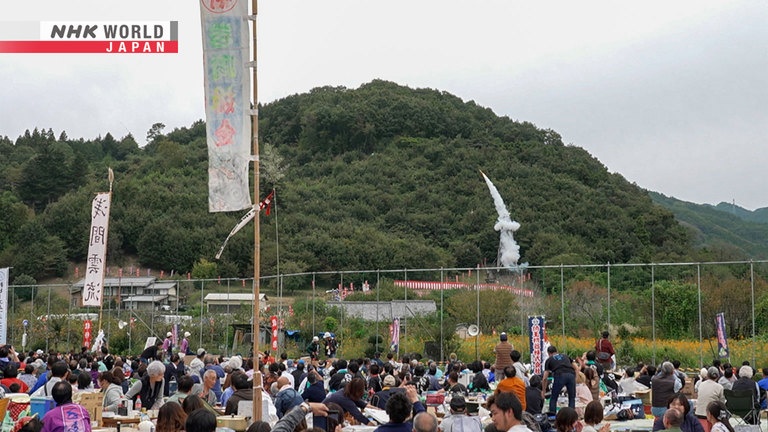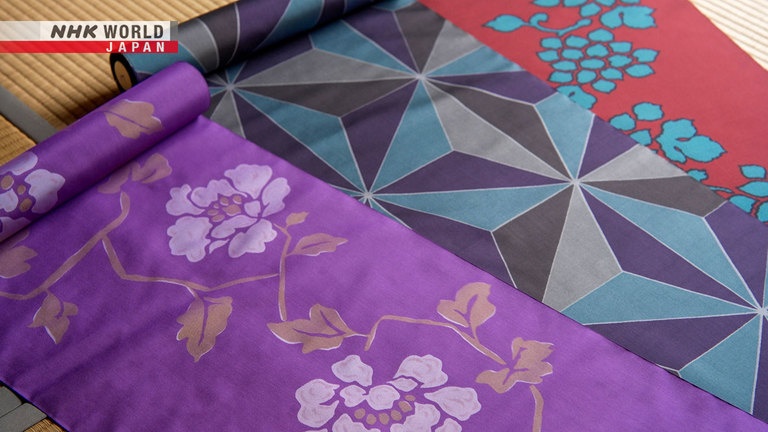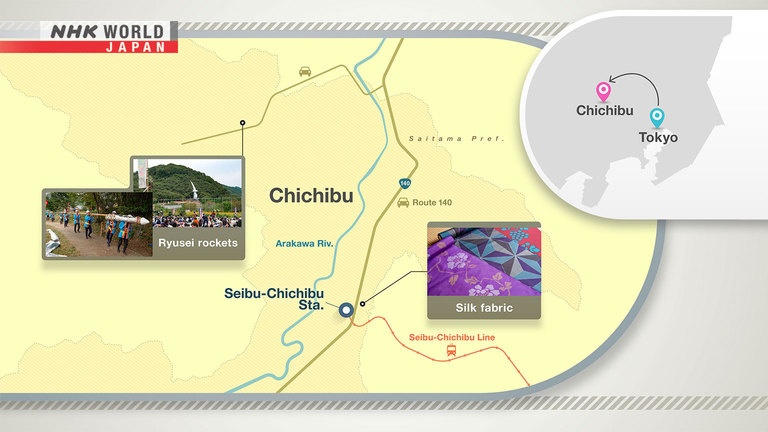The Soaring Dragons of Chichibu
Chichibu in Saitama Prefecture is a charming, rustic spot not far from Tokyo. It is known for its hundreds of annual festivals. These include the Chichibu Night Festival, as well as one that features rockets. In the Yoshida Ryusei Festival, which takes place in October, locals handcraft rockets that are launched high in the air and release colorful decorations or firework clusters on the way down. We meet the people who are passing down this special tradition.
Yoshida Ryusei Festival

This festival, which is a kind of prayer for a rich harvest and good fortune, has continued for more than 400 years. The residents of Yoshida spend about three months building the rockets, which are made from hollowed out cedar bound by bamboo strips. 27 districts show off their spectacular rockets.
Chichibu Meisen

Meisen is a traditional silk fabric produced in Chichibu, known for its rich sheen. The people who pull the Chichibu Night Festival floats wear kimono made from this fabric.
Access

Chichibu is just 80 minutes away by express train from Tokyo's Ikebukuro Station. The Yoshida area can be reached by local bus or taxi.
Transcript
"Journeys in Japan"
Chichibu is cradled in sacred mountains.
And watched over by guardian shrines.
Festivals, some 400, mark every season,
including one that takes place after dark.
And another that looks to the skies...
with handmade rockets devised hundreds of years ago.
Dozens of rockets are launched, as a form of prayer.
If they soar to great heights, a good harvest awaits.
Our rocket made it!
Maxwell Powers is a voice actor from the United States.
A big fan of festivals, he travels all over Japan to enjoy them.
Hi, I'm Max and we're here in Chichibu, Saitama,
to witness something really amazing.
The launch of a traditional rocket
in a festival that's been going on for hundreds of years.
What's really amazing about this
is that NASA engineers actually studied this thing,
and they say that it's not so different from the modern rockets we use today.
So, we are going to go and explore the Ryusei Matsuri.
Let's delve into the mystery, and the magic,
of 400-year-old spectacular rituals on "Journeys in Japan."
The Soaring Dragons of Chichibu
Chichibu is in northwestern Saitama Prefecture,
just 65 kilometers from Tokyo.
The city is surrounded by gorgeous nature.
Autumn is in the air and the rice fields are turning a golden brown.
Chichibu has long been a site of mountain worship and pilgrimage.
Some 100 temples and shrines dot the area.
(Muku Shrine)
Places all over Chichibu like Yoshida here,
are built around shrines like this in the mountains
and there are lots of unique traditions and cultures that come along with it.
One of those is going to be held in October, here at the Muku Shrine
and it is called the Ryusei Matsuri and it is one-of-a-kind.
And not only that, we're going to get to see how they're preparing for it.
Let's go.
Hello. You must be Kurosawa-san.
That's right.
I'm Max. Nice to meet you.
I'm Kurosawa.
Are you already preparing for the festival?
Yes. It is in October, but we start prepping from July.
From July? That's an early start.
Kurosawa Haruo's family has been making festival rockets for generations.
They belong to the To'un School,
and compete against the schools of 26 districts
to show off their style and technique.
Rockets are crafted from hollowed-out lengths of cedar and bamboo strips,
using methods largely unchanged for hundreds of years.
Kurosawa is working on the gunpowder tube which will become the engine.
It's reinforced with tightly-bound bamboo,
so that it won't fall apart on launch impact.
We use this tool to split the bamboo.
That's cool.
It's still loose. So, I'll redo it.
Do you know when it's tight enough?
Yes, it's intuitive.
This is about right.
We pack this with gunpowder at the final stage.
The gunpowder is only packed into the tube
and attached to the rocket the day before the festival.
This is the Ryusei shed on my property.
We store our tools inside.
We raised silkworms there for the Chichibu textile trade.
Since that industry faded, we've been using the shed for the Ryusei Festival.
- Would you like to look inside?
- I'd love to.
So, if you check out these stairs, they're really steep,
which is actually a point that shows you
that this building is probably over 150 years old.
They haven't built things like this since about back then. It's incredible.
Oh, wow.
The "Rocket Studio" is large and... private.
This is crucial, as their carefully-planned designs
and construction methods are top secret.
This confidential notebook was handed down to Kurosawa
from the school's former leader.
This is a sheet of "washi" paper.
We piece together around 50 sheets.
Sheets of washi are pieced together to create the parachute.
Crumpling the paper this way makes it even stronger
and more resistant to tearing.
Some competing districts now use cloth,
which is easier to handle, but here, tradition prevails.
We used to be told to learn by observing.
But learning techniques that way was actually very difficult.
I've taken on the role of teaching the traditions
to the younger members of this school.
I hope they'll inherit them to pass on to the next generation.
The town of festivals, Chichibu.
Hundreds are held throughout the year.
So, these are replicas of the parade floats or "mikoshi"
that are used in the "yomatsuri" here in Chichibu during December.
So, these get pushed all over town by the people of the town.
The Chichibu Night Festival goes back over 300 years.
People pull the opulent floats,
applied with urushi lacquer, through the streets.
The festival's origins are linked to a regional craft.
Silk, used in gorgeous textiles, like these.
Hello. I'm Max.
- Hello.
- It's nice to meet you.
Arai Norio is the third-generation owner of this silk textile-maker.
Tell me about the process?
This is our "sakizome" textile.
It is distinctive for the contrasting colors
used in the warp and weft threads.
The warp is purple and the weft is a reddish color.
So, it looks purple or red according to the angle.
There's a sheen to it. It's beautiful.
It's amazing how the color changes.
Our textiles have great potential for their subtle expressions.
I'd like more people to know about them.
Late September, just two weeks to festival time...
Tonight, the other members of the Ryusei
are all gathering at Kurosawa-san's house,
and this should be pretty interesting because we got invited along.
- Hi.
- Hi Max! We've been expecting you.
- Thanks for inviting me.
- Come on in.
Women are preparing a local specialty called "katemeshi,"
which is served at festival gatherings.
This rice dish, with root vegetables and other ingredients,
has been around since the Edo period.
This area is mountainous.
Rice yields were low due to the lack of flat land.
So, people used lots of ingredients to bulk up the rice dishes.
Otherwise, they wouldn't have gotten full.
I think that katemeshi means to mix and cook many things.
Everyone loves this dish.
Kurosawa and his daughter are practicing for the festival.
Be careful with the pitch.
Want to try again?
The entire land, the entire land.
What's the significance of that?
It's called "koujou" for the words offered before launching the rockets.
Without this they can't be ignited, so won't go up.
It's an honorable position.
Traditionally, men performed the koujou,
but in 2015 Kurosawa appointed his daughter.
I think that there are aspects of traditions that must be adhered to.
But there are others that can evolve.
You have to be discerning,
and hand them down according to the times.
Members from other districts visit the Kurosawa home,
once unthinkable in a guarded tradition.
Cheers!
And the main topic of conversation is... rocket design.
The new generation is opening up.
You can guess from the total weight.
We only prepare gunpowder at a ratio of 6.5.
3% of 6.5 would be... about 170cc?
Hundred ninety.
I'm talking about the three ingredients to make gunpowder:
you mix saltpeter with charcoal, and add water in the end.
The amount of water determines whether the gunpowder is strong or weak.
We can exchange such information at these gatherings.
Everyone here is from a different school,
does that make you competitive?
- Not a bit.
- I think that is a thing of the past.
But people used to be.
Whose rocket went up, or didn't?
But with that attitude our tradition won't carry on.
Look at us. This kind of interaction is necessary to keep the festival going.
There used to be many secrets.
People would never talk about their techniques.
We now all talk frankly.
Here we go.
Now that's excellent.
It's very sweet, savory.
There's a deep umami.
It's great.
The day before the festival...
people are busy adding the finishing touches.
Last year the parachute didn't open. It was disappointing.
So, I hope this year everything goes well and successfully.
Looks good. I think it'll be okay.
Kurosawa's team begins attaching the engine section.
It must be secured firmly, otherwise the rocket won't shoot straight up.
Everyone, come here.
This one's from one sheet of paper.
Two sheets, for processing, and for blasting wire.
These are the very basics, so you've got to remember it.
I taught you yesterday, right?
I'll check until I'm satisfied.
If I compromise and that leads to an accident, I'm just going to regret it.
There's no compromising here.
I have no idea how it'll turn out tomorrow until we ignite it.
That's the exciting part about it.
That's why it keeps you hooked.
At daybreak, Kurosawa visits the grave of his school's former leader.
I prayed he would look over us,
so that the Ryusei soars high and succeeds.
- Good morning, Kurosawa-san.
- Good morning.
I'm looking forward to today's event.
You're a To'un school member today, so put this "happi" jacket on.
- Here's your armband and helmet, too.
- Great.
A Shinto priest prays for safety and blesses the festival.
And the rocket spectacle is about to get underway.
Each district's team marches in, carrying their 20-meter-long rockets.
If their rocket surges skyward and, at its zenith,
releases its "secret" decorations or firework clusters,
and the huge parachutes open beautifully...
only then, can it be called a success.
But... they need a lot of luck.
More than half of the launches end in failure.
At last, the moment has come for Kurosawa's team.
I won't say it out loud, but I'm nervous.
You just have to accept whatever's coming.
I'm ready now.
The entire land, the entire land.
OK. Pull that out.
An offering, an offering.
Open! Open up.
We did it!
We really worked hard.
I'm so happy.
Thank you so much. Cheers!
- It was fantastic.
- Thank you.
How are you feeling?
Happy. That expresses it all.
To all the members of our school, our families,
and people involved who worked so long - I feel so grateful.
I'm relieved the Ryusei ignited and did a great flight.
I'm sure the teams that failed will try much harder.
We succeeded, but we're aiming for higher goals.
Next year, we're going to launch a better Ryusei.
The Yoshida Ryusei Festival reaches its finale in the late afternoon.
The "Dragon Rockets" soared
with people's wishes for good fortune and wellbeing.
So, it has been a wild couple of days.
The atmosphere of the festival was just incredible.
Everyone was so nice
and more than anything, it was amazing just to watch this happen.
And it's wonderful to see
how these traditions are being passed on to the next generations.
And I hope this festival is going to have a long, long future.
I highly encourage everybody to get out of Tokyo.
Come visit Saitama.
Come visit Chichibu, come visit Yoshida and experience this festival.
It is amazing and it will blow you away, figuratively.
To reach Chichibu, catch an express train from Tokyo
for the short 80-minute journey.
The Yoshida district is easily accessed by local bus or taxi.
In Chichibu, visitors can join a textile workshop
where they can learn silk-screening, weaving, and indigo-dyeing.
Tadah!